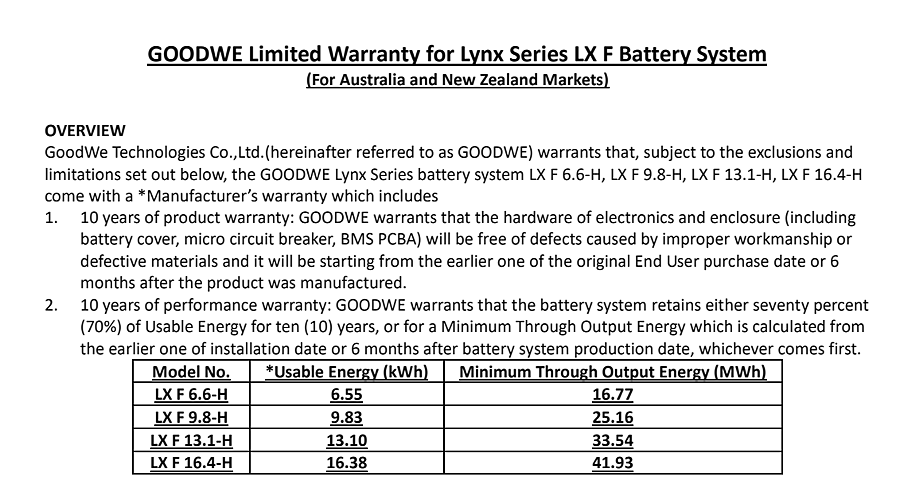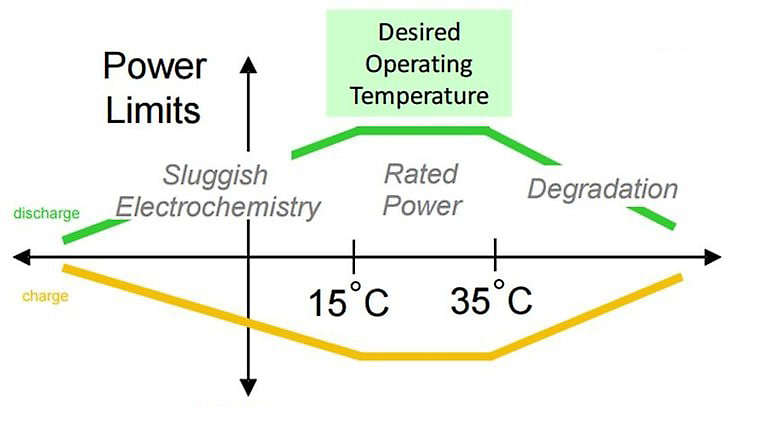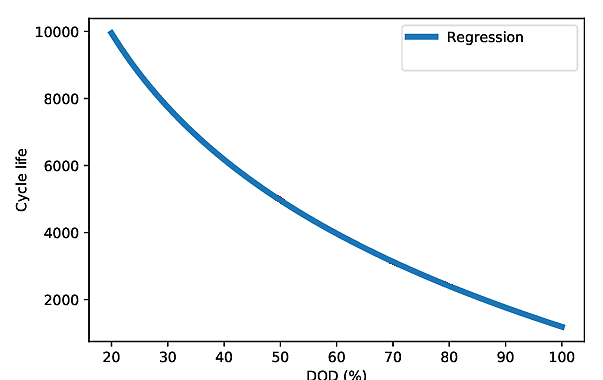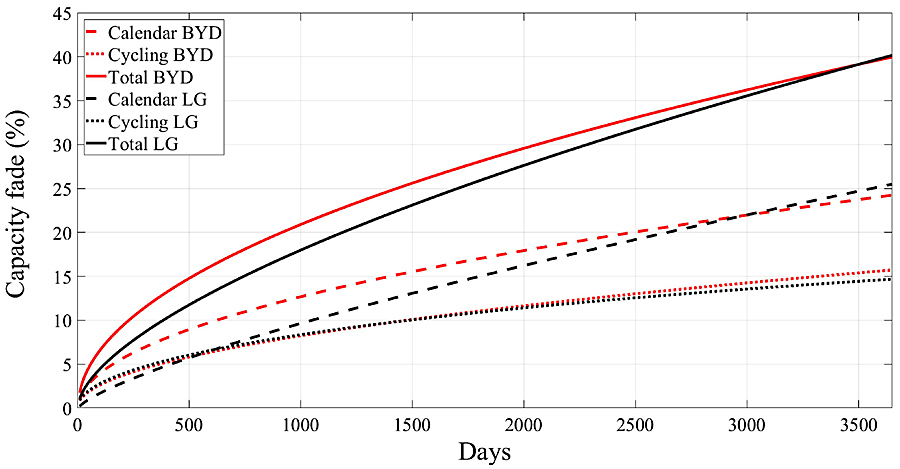
The short answer: Expect a home battery in a temperate climate with typical use to last 15 – 17 years. Solar batteries exposed to higher temperatures, and worked hard every day, could have an effective life of 12 – 14 years.
The longer answer:
Treat your solar battery with the care you’d give to a newborn in nappies, and it’ll still be powering when the kid asks you to borrow the car keys. Neglect it, and the lights might be out before that child finishes primary school.
Unlike your children though, your home battery comes with a guidebook to secure its longevity. With that guidebook and the help of some scientific research with hands-on experience, this article will attempt to provide some insights to extend your battery’s lifespan, which won’t be anywhere near as demanding as your firstborn.
Defining End-Of-Life For A Solar Battery
Off-Grid
In off-grid solar battery systems, the concept of ‘end-of-life’ is better defined compared to grid-tied systems. In off-grid setups, the battery serves as the primary energy source, and there will come a point where its capacity and performance have degraded to a level where it can no longer support the load. Then it’s lights out.
Grid-Tied
For grid-tied systems with backup capabilities, the definition of end-of-life is less straightforward, as the battery can still be useful for backup purposes even if its capacity has significantly degraded, as long as it can meet the essential backup load requirements during power outages.
If the main function of a grid-tied battery system is for peak demand management to reduce electricity bills, it can be even more challenging to precisely determine the end of life. Unlike an off-grid system, the grid invisibly steps in to provide power when needed.
Manufacturer’s Warranty Period
The end of the manufacturer’s warranty period, typically 10 years1, and/or exceeding the warranted number of cycles, is often considered the end-of-life when justifying a solar battery’s economics.
However, in reality, the lifespan might be longer if treated well, because manufacturers typically design their warranties with a degree of conservatism. The SoH (State of Health) designated under the warranty is set to ensure a reasonable level of battery performance, as long as it’s operated within the manufacturer’s specifications.

GOODWE Limited Warranty for Lynx Series LX F Battery System shows a 10-year product and performance warranty of 70% useable energy and a minimum throughput based on battery size. Image: GoodWe
What Are The Symptoms Of A Degraded Solar Battery?
The symptoms can vary depending on chemistry, design, and usage. Here are some common signs that might indicate an end-of-life battery in a home solar storage system:
Reduced Capacity: One of the primary indicators of an aging solar battery is reduced capacity. You may notice that it holds less energy than it used to, leading to shorter discharge times.
Frequent Recharging: As the battery’s capacity decreases, it may require more frequent recharging to maintain the same level of performance. You might find yourself needing to charge it more often than before.
Decreased Performance: The battery’s ability to deliver power might diminish. This would become more conspicuous when the system is in backup mode or in an off-grid configuration.
Increased Heating: Ageing batteries can experience increased internal resistance, generating more heat during charging and discharging. If you notice it becoming unusually hot during normal operations, it could be a sign of degradation.
Unexpected Shutdowns: An end-of-life battery might experience unexpected shutdowns or interruptions in power delivery, particularly noticeable during periods of high demand when it struggles to provide the required energy.
BMS Warnings: Many modern systems have a Battery Management System (BMS) that monitors the battery’s health. If the BMS consistently alerts you to issues, it could be a sign that it is reaching the end of its useful life.
Factors That Affect The Lifespan Of A Battery: The Big Three
#1 Temperature Extremes
Like you and me, a battery works more efficiently when not subjected to extreme temperatures. The sweet spot is similar to ours, too – around 20 to 25ºC. The large temperature variations in many parts of Australia don’t do solar batteries any favours, so expect them to last longer in temperate zones or temperature-controlled environments.
Exposure to temperatures above the recommended range accelerates chemical reactions within the battery, leading to faster degradation of its components. High temperatures also cause capacity to decline rapidly, resulting in a shorter usable lifespan.
Frequent exposure to extreme cold can also decrease a battery’s efficiency and contribute to long-term degradation of its capacity and overall lifespan. Severe cold can even lead to mechanical stress on the battery, potentially impacting its structural integrity.

Optimal operating temperature zones and characteristics for lithium-ion batteries. Image: Researchgate
#2 Number Of Charge/Discharge Cycles
It’s not by accident that many manufacturer’s warranties are linked to the number of charge/discharge cycles in a solar battery’s life. Each cycle contributes to gradual wear and chemical changes, leading to capacity degradation over time.
Lead-acid energy storage is more affected by the number of cycles than lithium-ion batteries. Frequent cycling, especially deep discharges, can contribute to sulphate buildup on the battery plates, which reduces capacity and shortens its lifespan.
Lithium-ion batteries can tolerate a higher number of cycles and deeper discharges. Minimizing the frequency of cycles through efficient energy management can help extend the its longevity, no matter the chemistry.
#3 Depth Of Discharge (DoD) And State Of Charge (SOC)
The Depth of Discharge (DoD) is the degree to which a battery is emptied relative to its total capacity. A large DoD significantly impacts lifespan of a battery by affecting the amount of stress placed on its chemistry. Shallower discharges, where it is not fully drained, lead to slower capacity degradation and extended overall battery life.
A manufacturer’s battery warranty often includes stipulations related to the DoD. For example, a manufacturer might specify that a lithium-ion battery should not be regularly discharged beyond a certain percentage of its capacity (e.g., 80% DoD) to maintain warranty coverage. Exceeding these recommended DoD levels can lead to accelerated degradation that some warranties may not cover.
State Of Charge (SoC), on the other hand, indicates the current charge level of a battery as a percentage of its maximum capacity. Manufacturers of Li-ion batteries may recommend avoiding consistently charging it to 100% SoC. While these SoC limits might not be as prominently mentioned as DoD limits, adhering to appropriate SoC levels can help preserve the solar battery’s capacity and lifespan.

Regression curve of Lithium-ion battery cycle life vs DOD. The graph indicates that a shallower discharge will extend the cycle life. Image: Researchgate
Empirical Studies To Determine Solar Battery Lifespan
Empirical research involves collecting data through observation and experimentation to draw conclusions, rather than theoretical analysis. Many such studies have been undertaken in recent years aiming to determine the likely lifespans of batteries.
One study in particular, titled ‘Lifetime Expectancy of Li-Ion Batteries Used for Residential Solar Storage‘, aimed to give a definitive answer to what seems like a rhetorical question. Researchers engaged in hands-on experimentation with 24 lithium-ion batteries, simulating real-world conditions to determine their lifespan. This is what they did:
Temperature Effects: Solar batteries were exposed to a range of temperatures to emulate the various climatic conditions they may be installed in. The study noted those exposed to higher temperatures aged more rapidly, indicating that you might see a bit faster wear in the northern regions of Australia than down south.
Charge/Discharge Cycling: By simulating the daily load profiles of average households, researchers could track the battery charge/discharge cycles to see how it affected them over time. As expected, those that were put through more frequent charge/discharge cycles showed signs of quicker degradation.
Depth of Discharge Impacts: Batteries were subjected to various depths of discharge. Some were shallow cycled, while others were almost entirely drained. No surprises – those subjected to a deeper depth of discharge before recharging degraded faster than those that weren’t.

Degradation evolution throughout 10 years under warranty conditions for two commercial Li-ion battery packs analyzed in the study. Image: MDPI
How Did The Numbers Stack Up?
The outcome of this study suggested you could expect your solar battery to last beyond its 10-year warranty. Researchers found that batteries kept in temperate climates and had average use could last between 15 to 17 years. On the other hand, those exposed to higher temperatures we might see in the hotter regions, and pushed hard every day, could have an effective life of 12 to 14 years.
Bear in mind this is only one such study. In another testing facility, solar batteries haven’t fared so well. The recently closed Canberra Battery Test Centre published a report in which the outcome of 26 batteries tested over 6 years was found wanting. After a good hammering, only 2 out of the 26 were fault-free, although no numbers were given for estimated lifespans.
Testing Times And Insights To Prolong Battery Life
Regardless of any outcomes from studies undertaken, there’s no argument that the lifespan of a solar battery hinges upon just a few key factors – reducing temperature extremes, managing the charge/discharge cycles, and minimizing the depth of discharge being the main ones.
I’m confident that you won’t have to nurture your battery like a baby, and with some common sense, it will happily outlast the 10-year warranty period.
Footnotes
- Props to Enphase & Q-Cells, which warrant their batteries for 15 years, and Zenaji, which offer a 20-year warranty – albeit with lots of carve-outs for temperature exposure. ↩

 RSS - Posts
RSS - Posts



I appreciate that deeper discharge affects the longevity of the battery in terms of days, but for those utilising batteries to minimise electricity bills, it needs to be measured in terms of total charge usability.
eg. If discharging 20% of the battery every night gives you 20 years of use, but discharging 40% of the battery every night gives you 15 years, then you have utilised more battery capacity by the 40% discharge and therefore got better value for money.
So I think you are measuring the wrong thing
Hi Derek. Yes, but does 20% discharge give X number of years, and does 40% discharge give Y number of years? You’re right, I think there are some cases where hammering a battery harder might end up with a better economic outcome depending on other factors. Re – measuring the wrong thing? I see your point, but this article is about how many years solar batteries last, why that is, and how to prolong their life if you want to. Hopefully there’s enough info here to help readers understand the factors at play.
Good you mentioned Zenaji: We use most of our battery every night (basically to cover peak evening: 12Kw, & we use abt 10Kw.) 20,000 cycles should see us out. We also use power during the day to reduce peak usage.
Hi Kim. Yes, the article is a good start to analysing the issue, but could lead to people making poor financial decisions on the basis of only one factor. I was just pondering this and realised that short lifespans aren’t always a bad thing.
eg. In 2004 I spent a huge amount of money on a high quality TV. This TV is still working today. Good value for money? No, because I could buy the same quality TV today for $300, and meanwhile I’m stuck with a small TV that is still working. I would have been better off buying a cheaper TV (half the price) that stopped working in 10 years and then spent the same money again on another 10 year TV which would have been much bigger and better. Same amount of money spent, but better results.
The battery price worldwide has been dissappointing stubborn and staying high, but eventually it will drop. Probably not in the next few years, but eventually. I think we are better leaning towards cheaper batteries with lower capacity and lower lifespan, and save the money for what will come.
Hello again Derek. That’s one strategy many people try. I’m not sure if the economics play out favourably even in the short term as you’re suggesting. It certainly does nothing to contribute to the disposable world we live in. Good luck with the cheap battery!
I seem to remember reading the results of a large-scale report of battery life on this blog about a year ago. It was done in the ACT I think.
What you reported then was that the technology was still too immature as every brand (including Tesla) suffered from premature failure, many lasting only 2-3 years before having to be replaced under warranty. Now you’re saying the technology is so improved they can go for up to 17 years?
Unless my recollection of the earlier report is completely misguided (this is perfectly possible), it might have turned it into even more of a good-news story if you had mentioned this sudden turnaround in performance?
Hi,
No actual test results for SoC? I’d be interested to read what effect charging to 100% (I.E. 3.65V/cell) has compared to lower values. I have any each-way bet: house bank is charged to 3.45V/cell, and caravan 3.65V/cell. Lowest is whenever the lights go off.
dRdoS7
Given the DoD and SoC effectively defines upper and lower limits to a cycle it seems to me that batteries should be oversized. For instance, if my overnight usage is 10kWh getting a costly matched battery is going to have a shorter life. The question is, what size better should I get to improve longevity of the battery and is that worth the extra cost. This might also be what Derek McKinnon was thinking about in his comment
Hi Nathan. Yes, batteries should be oversized for longevity. You are 100% correct that the DOD and SOC define the upper and lower limits. Your question – what size better should I get to improve longevity of the battery and is that worth the extra cost? That’s the million dollar question. As far as I know there is no one-size-fits-all answer because of the many variables for each different user.
Hi Kim,
You talk about minimising discharge capacity to prolong the life of the battery but as a residential user how do you physically do that? Does the battery also warn you that it is nearing the end of its discharge every night? And what would be the point of saving 15kwh (for eg.) of electricity every day via the battery if you can’t use all of it back in the night when you need it, especially if you use say for example 18kwh per night.
Hi Sharon. The maximum DOD or minimum SOC is able to be customized in many batteries. It may be accessible in the app. Sometimes the battery mode of operation has a preset minimum SOC. If you have no luck there, the installer may have access through their portal, or at least they can tell you if it can be set. You should run to battery to the minimum state of charge that you feel benefits you the most. It’s your battery and so your choice!
It’s such a pity that so called experts keep leaving out the most critical technology available today for LOW COST energy storage. LTO ticks all the boxes. It’s by far the safest, longest lasting, temperature tolerant lithium technology available today. Zenaji, an Australian company developing LTO batteries puts a 20 YEAR, 22000 cycle warrpanty on it’s LTO home battery.
LTO has other advantages as well such as its ability to charge quickly, (important on cloudy days), its ability to provide for high current draws, and it’s super efficiency.. Moreover it can be happily charged and discharged multiple times per day enabling users to take full advantage of low cost power pricing whenever it occures.
Yet another advantage of LTO is that it can be fully discharged by the during every cycle with no damage to battery life. This simply not the case with other lithium batteries.
These comments are not aimed at the writer of the article but the question has to be asked as to why LTO and its advantages are not discussed or even mentioned. Is the writer simply not aware of them or are other factors at play? Yes, LTO MIGHT be more expensive initially but it will deliver the lowest cost of storage by a long way. over the life of the battery.
I have a LG RESU6.5 lithium Ion battery installed inside my garage in the NSW mid north coast region which would be considered a temperate climate. I can see in the data my Goodwe hybrid inverter produces that the battery is being fully charged and deeply discharged every day and I have no hardware or software ability [that I know of] to prevent the battery discharging to a 10% SOC or recharging to 100% every day. Your article highlights to me that this daily routine is likely to degrade my battery faster than average and probably void my warranty.
What can I do to achieve average use and make sure I comply with my warranty conditions? I don’t think I have any way to avoid the daily deep discharges so how can I manage the charge/discharge cycles?
Hi Greg. The Goodwe SEMS app allows you to customise the depth of discharge for a Goodwe Lynx battery. I’m not sure if it has the same level of interrogation with your LH RESU battery. You should ask your installer.
I live on mid nth coast nsw. I own a tesla battery, on my phone app it says it won’t discharge 100%, it will stop at 5% charge & wait for the Sunshine in self sufficient mode, (no grid top ups). Purchased in 2017. Battery produces between 20 – 25kwh a day. Of that I use 7 to 10kwh, the rest & suspect more goes back to grid. So at sunset with 100% battery charge I’m only using between
30% to 40% every night. I don’t see battery discharge or cycle daily it starts day with 60% charge from previous day & is at 100% charge by 10.30am to 11.30am. The rest to grid after that. Does that sound right?. .
Am I being overly Machiavellian to suggest that I really want my battery to be replaced under warranty in year 10 of my 10 year warranty? Or have I just not read the warranty closely enough when I think I’ll get a new battery in 9.5 years time?
And on another tangent my sungrow batteries are modular. Would adding another module in 5 years time work? Or do the set of batteries need to be close in age and performance?